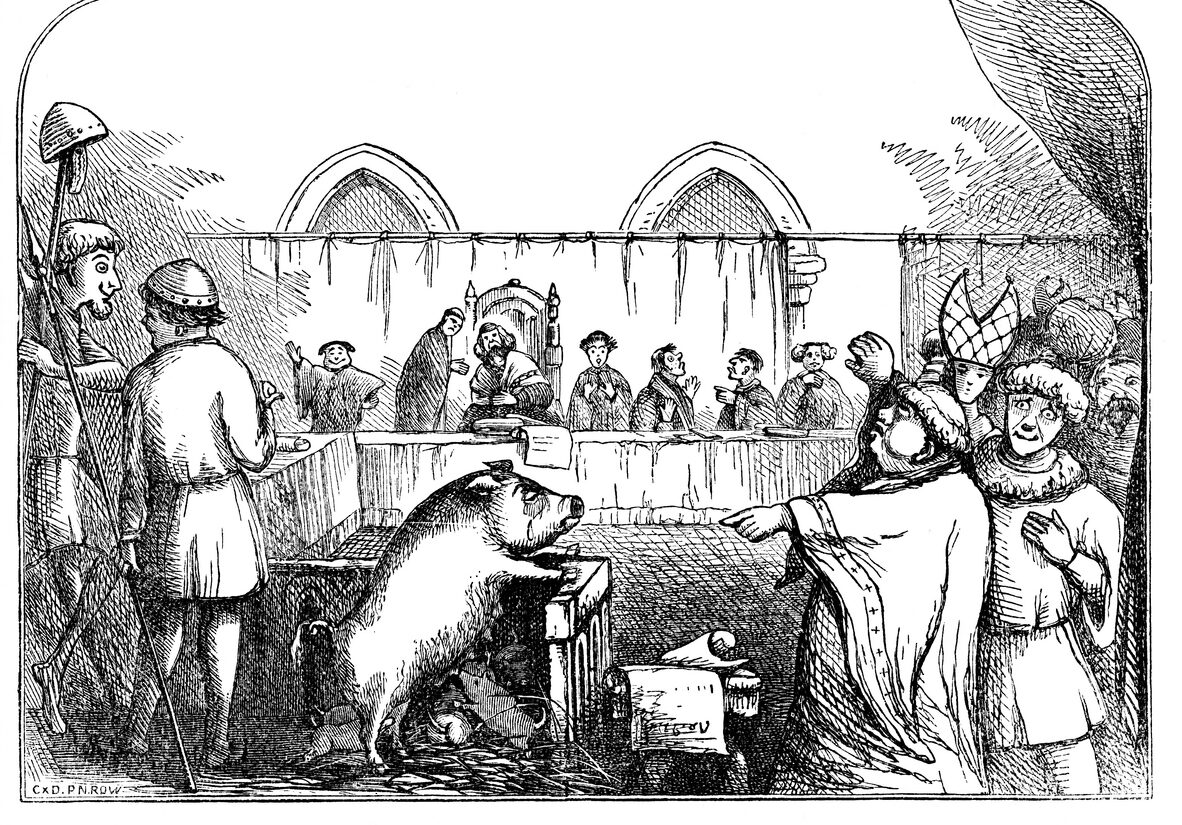 Getty Images/iStockphoto
Getty Images/iStockphotoAt various points in history, animals have been hauled before courts and held accountable for crimes ranging from property damage to murder. These weren’t metaphorical accusations or symbolic events—these were actual trials, sometimes complete with lawyers, judges, and verdicts. In many cases, the animals were assigned legal representation, and trials could stretch out over weeks or even months. As bizarre as it sounds today, these events reflect how humans once tried to impose moral order, divine justice, and social control on the natural world in ways that now seem absurd but were once taken very seriously. Here are some of the strangest times animals were put on trial—and punished.
The pig executed for murder – Falaise, France (1386)
One of the most infamous animal trials took place in the Norman town of Falaise. A sow was arrested for allegedly killing and partially eating a child. In an attempt to mirror the severity of the crime, the pig was clothed in a waistcoat and breeches and brought to trial like a person. Witnesses testified against it, and a local executioner carried out the sentence: the pig was publicly hanged in the town square. The event was widely reported and serves as one of the clearest examples of anthropomorphising animal behaviour to fit legal and moral frameworks designed for humans.
The weevils sued for crop damage – St. Julien, France (1587)
In the diocese of St. Julien, a local court took on the case of vineyard owners versus a swarm of weevils accused of decimating the year’s grape harvest. The court appointed an advocate for the insects, who argued eloquently that as creations of God, the weevils had a right to live and feed. After months of deliberation, the court decided to offer the pests an alternative plot of land to inhabit peacefully. When the weevils failed to appear—or relocate—the case was quietly dismissed. It remains one of the most surreal legal attempts to negotiate coexistence with nature.
The rat that avoided arrest – Autun, France (1508)
The rats of Autun were charged with destroying crops, a crime that threatened the food supply and angered local authorities. A summons was issued for them to appear in court. When they failed to show, the defence lawyer argued that the rats’ journey to court was fraught with peril—especially because of the many cats along the route. Astonishingly, the court accepted this argument and postponed the case indefinitely. This episode is often cited as an example of how medieval legal systems applied procedural fairness even in absurd situations.
The rooster tried for laying an egg – Basel, Switzerland (1474)
A rooster found to have laid an egg—a biological rarity often caused by a condition known today as testicular ovotestis—was believed to be involved in witchcraft. Locals brought the bird to trial, fearing it might be a demonic omen. The court heard testimony, and the bird was found guilty of sorcery. It was burned at the stake, in a trial that reveals not just superstition, but how anxieties about unnatural phenomena were channelled through formal legal procedures.
The donkey praised and spared – Guglielmo, France (1750)
In a reversal of many other trials, a donkey accused of being involved in a sexual act with a man was acquitted after character witnesses testified on its behalf. Villagers swore that the animal had always behaved with dignity and was clearly the victim in the matter. The man involved was sentenced to death, while the donkey was led back to its stable, unharmed. This case is notable not just for its absurdity, but for the remarkable use of witness testimony in defence of an animal’s character.
The dog sentenced to death – Vanves, France (1600s)
A hunting dog was brought to trial for attacking people and livestock in the village of Vanves. Treated much like a human defendant, the dog was given a formal trial with accusations of malicious intent. It was found guilty and executed. The case highlighted how, in the eyes of the legal system, animals could be subject to the same standards of intent and culpability as people—despite lacking any real concept of moral responsibility.
The termites evicted by court order – Brazil (early 20th century)
In one of the more modern instances, a convent in Brazil found itself under siege by termites that were damaging the building’s foundations. The nuns, exasperated, took legal action. In a display of old legal traditions meeting the 20th century, a judge issued a formal eviction notice for the termites. It was written in Latin, nailed to a tree on the grounds, and read aloud to ensure the termites had been fairly warned. Though clearly symbolic, the case demonstrates how remnants of historical legal customs have lingered long past their logical expiry date.
The caterpillars of Lausanne – Switzerland (1479)
Caterpillars were accused of ravaging crops in the Lausanne region, and an ecclesiastical court summoned them to appear. After no appearance, the court appointed a lawyer to represent the caterpillars and ordered days of fasting and prayer to resolve the issue. The result? A judgement was issued ordering the caterpillars to vacate certain fields under threat of divine punishment. The absurdity lies not only in the legal proceedings but in the mixture of religious ritual and judicial power used to handle what today would be considered a pest control problem.
The dolphins of Italy – 16th century
In coastal Italy, a group of dolphins were blamed for disrupting fishing by stealing catches and damaging nets. Local fishermen petitioned authorities, and a symbolic court hearing was held in which the dolphins were found guilty of theft. While the sentence wasn’t enforced—no one attempted to capture or punish the animals—the act of declaring them criminals on record shows how economic frustrations could be channelled into judicial theatre.
The fly excommunication – Bern, Switzerland (1478)
In yet another curious case, a swarm of flies infesting a church was subjected to ecclesiastical trial. The bishop ordered an exorcism and formal excommunication of the insects, declaring them removed from the Church’s domain. While seemingly farcical, this reflected a worldview in which every being, however small, was seen as subject to divine and legal authority.
While these stories often provoke laughter today, they also reveal something profound about how past societies understood responsibility, justice, and the boundaries between human and non-human. In trying to impose their moral and legal systems on the animal kingdom, our ancestors showed both the limits of their knowledge and the strange ways they coped with the chaos of the natural world. These trials weren’t just about punishment—they were about making sense of a world that didn’t always seem to play by the rules. And while we no longer put pigs or rats on trial, the impulse to assign blame and enforce order remains deeply human—even if the courtroom no longer contains a goat in the dock.



